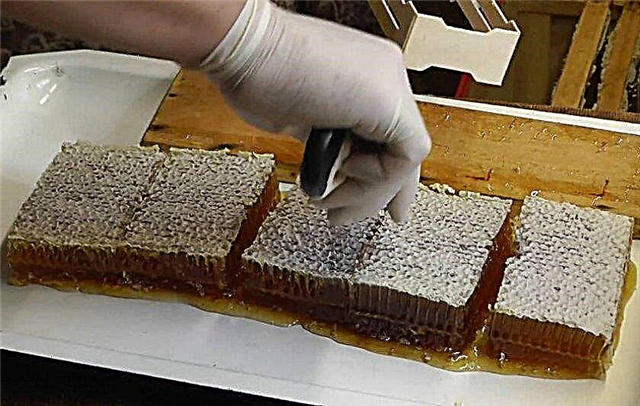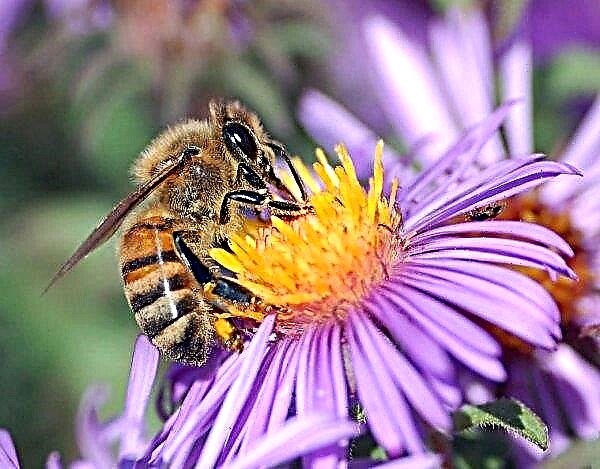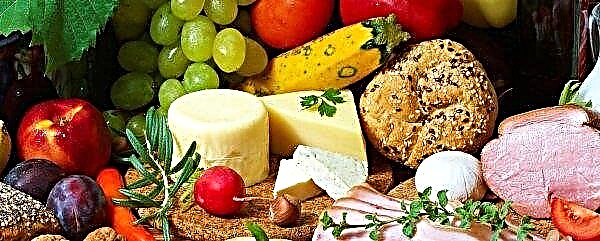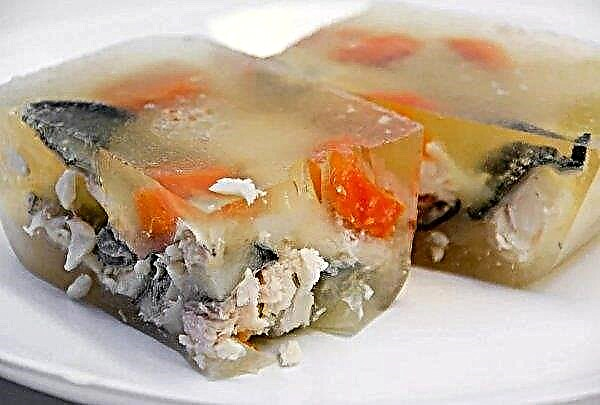There are different types of honey. Bees can collect nectar and pollen mainly from one plant or from many honey plants. In the latter case, a multifleered product is obtained, which will be discussed in the article.
Did you know? The composition of honey is approximately 300 substances, of which 42 — carbohydrates, most of all in it fructose and glucose. The complete composition of this product has not yet been studied; coloring materials are least studied.
Description and characteristic
The product collected from many honey plants in different areas and at different periods of time will differ in color, smell and taste. For these reasons, the characteristics of this type of honey vary greatly. Color can be anything from light yellow to dark brown. The taste is also different - tender, sharp, varying degrees of sweetness. The smell has floral-fruity notes. The crystallization period and viscosity of the product may vary. Calorie content can vary between 303–330 kcal.

Like any honey, it is a carbohydrate (up to 86%) dissolved in a small amount of water (up to 21%). The composition also includes organic acids, a small amount of vitamins and minerals, protein. There are also enzymes, essential oils, sterols, dyes, pollen.
What does polyfleur honey mean?
Polyfleur honey is a product collected by bees from various honey plants. It is also called simply floral. It contains pollen of herbs, from which it is difficult to distinguish the dominant honey plant.
What is the difference between polyfleur honey from others
Polyflera product differs from other species in that it does not have a specific collection period and a certain honey plant. If linden honey is mainly collected from linden flowers during its flowering period, then the variety under consideration is from different plants throughout the season. Only May honey, which is collected from different honey plants blooming in spring, is tied to this period. The composition of pollen in such a multifleral product is more diverse. Its aroma, appearance and taste are difficult to correlate with a certain honey plant, calorie content and composition are variable.
Monofleur varieties have certain characteristics. For example, linden honey contains 11–39% of linden pollen, has a light yellow color, a delicate aroma and a very sweet pleasant taste. The heather product contains 42–79% of heather pollen, has a dark brown color and spicy flavoring notes, crystallizes very quickly, so it is often sold directly in the comb. Flower products do not have such specific characteristics.
Types of Polyfleur Honey
The name of honey collected from different honey plants is usually called the collection area (meadow, field, mountain, forest) or the time of collection (May).
Did you know? The ancient Greeks believed that the gods would be granted immortality by ambrosia - a drink consisting of milk, nectar and honey: it was considered a source of longevity. The famous ancient Greek healer Hippocrates, who lived 110 years, consumed it daily.
May honey
Harvested the very first since the early honey plants - Hazel, coltsfoot, violets, flowering fruit trees and shrubs, wild strawberries, bird cherry, acacia, dandelions and other flowers. It is painted in yellow tones and has a slight floral smell. It has a pleasant sweet taste, in which there is no bitterness, does not crystallize quickly. The product gives strength and helps fight colds.
Meadow honey
Gather during the season from flowers growing in the meadow. Among them are many medicinal plants - St. John's wort, sage, thyme, clover, chamomile, dandelion, clover. This gives the product a special healing power and rich composition. The list of flowering meadow herbs depends on the location and time of collection, so meadow honey can be yellow or light brown in color. Such honey has a tangible pleasant aroma and good taste.
Field honey
Harvested from several flowering crops grown by man in the fields. Indeed, rapeseed and sunflower can grow not far from buckwheat. Of course, bees fly around not only cultivated plants, but also meadow grasses growing nearby, but its composition only benefits from this - such honey has both strengthening and healing properties. Most often it has yellowish shades.
Mountain honey
This is the most environmentally friendly product collected from the forbs of the highlands, including from very rare or medicinal herbs. Among these honey plants, sage, thorns and honeysuckle are often found. Among mountain nectars, varieties can be distinguished by the area of collection. So, for example, Altai is considered the most valuable: it helps with heart diseases, gastrointestinal tract and skin problems.
Forest honey
It is collected by bees from flowering trees, bushes and grasses growing in the forest and along its edges. Among these plants, briar, hawthorn, viburnum, mountain ash, blackberry, raspberry, strawberry, lingonberry, blueberry, fireweed, oregano, linden and heather often appear. The product usually has dark brown tones, but may be light yellow. In such honey there is always a fraction of padev, that is, collected from the sweet secretions of some insects or the sweet juice of plants. If the pade part was collected from coniferous tree secretions, then the healing properties of such a bee product are even stronger - this happens in areas with coniferous-deciduous forests.
Useful and harmful properties
Natural flower honey has many beneficial properties for the human body. Scientists have proven its antimicrobial activity, and interest in this product is only growing.
Did you know? Sometimes poisonous honey is found, collected from rhododendron, aconite, Labrador tea, privet, hellebore and some other plants - people who consumed it have headaches, delirium, impaired coordination and other signs of intoxication that pass through time. On the territory of the Russian Federation, it can be found in Transcaucasia, the Omsk and Tomsk Regions, and in the Far East.
- For a person, it can be useful as follows:
- This product perfectly helps with colds and viral diseases - for example, with sore throat, SARS, flu, bronchitis. The described sweetness has a softening and antiseptic effect in inflammatory processes in the throat. It can be gradually absorbed or consumed with a warm drink.
- With vitamin deficiency in the spring, the product in question is mixed with nuts and dried fruits (raisins, dried apricots, prunes). This mixture is consumed by 2-3 tables. spoons before meals. In addition, such a sweet medicine is useful for blood vessels and has a beneficial effect on cardiac activity.
- This antiseptic has a positive effect on the skin - it heals wounds, ulcers, burns, relieves inflammation, eliminates boils and pustules. To rejuvenate the skin, it is included in some creams and masks.
- Compresses from the product help with problems with joints, rheumatism, arthritis.
- It has a beneficial effect on the nervous system - it helps with insomnia, stress, with a depressed state, nervous and mental strain. It improves mood, gives a surge of energy.
- The polyflera variety is used in the rehabilitation period - it perfectly helps restore strength after an illness or surgery. It helps to make good energy losses to athletes after a strong physical exertion.
- A spoonful of honey, eaten on an empty stomach or dissolved in warm water with the addition of lemon juice, improves metabolism, strengthens the immune system, normalizes metabolic processes, strengthens blood vessels.
Video: useful properties of honey
It is worth noting that this sweetness is an allergenic product, its individual intolerance may also occur.. For these reasons, the product is not recommended to be included in the diet of pregnant and lactating women, as well as children under 3 years old. In addition, it should not be consumed in large quantities, as this can cause allergies or problems with the pancreas. With gastritis, you do not need to eat honey on an empty stomach.
Important! For diabetics, the sweetness in question can be consumed only after consulting with an endocrinologist, since it contains a lot of fructose and sucrose.
Ways to get honey
By the method of extraction, this product is:
- Centrifugal. Obtained by pumping from bee honeycombs using a honey extractor. The most common way to mine.

- Cell phone. It is honey together with honeycombs, which are the ideal packaging material. It is of high quality and most useful, but also costs more.

- Sectional. In this case, the sweetness is in certain sections of thin plywood or plastic. One section contains approximately 0.5 kg.

- Pressed. This product is obtained by squeezing honeycombs. It is rarely used, since the honeycombs deteriorate with this method, and this is very valuable material for beekeepers.

Rules and regulations for use
Dietary doctors recommend consuming polyfleur honey no more than 2 tbsp. l., or 50 g per day.
In this case, the following individual features should be considered:Did you know? All the ancient nations of Europe did from honey intoxicating drinks, the Slavs used them in rituals. In the Middle Ages in Russia this drink used at all family celebrations and at wake.
- Age. In the absence of contraindications, older people need to consume the product in the recommended doses.
- In the presence of physical activity, the norm can be increased.
- If a person has an allergy, then this sweetness should begin to be consumed with a small amount and observe the reaction of the body. If any allergic reactions occur, the reception of this sweet should be stopped.
- When used for medicinal purposes, the amount of honey can be increased to 150-200 g per day. But in this case, the duration of consumption should not exceed 60 days. For colds and viral diseases, this bee product is advised to mix with warm milk.
- When using sweets in order to reduce weight, the recommended dose should not exceed 2 tsp. per day. It is recommended to pre-dissolve it in a little warm water and add a slice of lemon. Such a drink, drunk in the morning, improves metabolic processes in the body.

With caution, honey should be given to children, as they are more sensitive to this product. Consumption begins with 1/2 teaspoon and gradually increase the serving in the absence of negative reactions.
If there are no allergic reactions, then it is recommended to adhere to such standards for admission:
- babies under 3 years of age, and especially in the first months, should not give the described product without consulting a supervising pediatrician;
- for children over 3 years of age, the prescribed norm is 30 g per day.

It is not necessary to mix this sweetness with hot drinks, since with such thermal exposure, some of the beneficial elements are destroyed. With hot tea it should be eaten with bite. The product goes well with cottage cheese, it can also be spread on bread and butter.
For gastrointestinal problems, this beekeeping product is consumed subject to certain rules:
- with an increased level of acidity, it is dissolved in warm water and drunk 1.5 hours before the main meal;
- with a low level of acidity, this sweet is dissolved in cold water and drunk a few minutes before eating.
Terms and conditions of storage
For storage, the product is placed in a dry and dark place. The optimum temperature regime is +6 ... + 20 ° C. This sweetness quickly absorbs odors, so it should not be stored with strongly smelling products or chemicals (paints, varnishes).
GOST recommends saving a store product of no more than 1-2 years, but in Europe the recommended shelf life is 3-4 years. In a cool, dry basement, the product can be saved for more than 8 years. In sealed containers and without access to light, antimicrobial properties can be stored for up to 10 years in room conditions.
Polyfleur honey is collected from forbs and is divided by the name of the area. It has no expressed characteristics and can be anything that does not detract from its usefulness. This product, which has few contraindications, should be properly stored and consumed at the recommended standards.
Important! Honey refers to products that should not be heated for a long time above + 40 ° C, since elevated temperatures reduce the healing effects of the product to zero. The exceptions are its alcohol solutions.
















